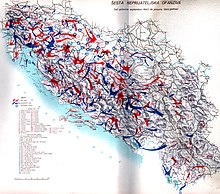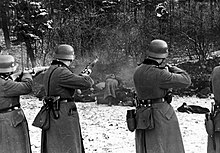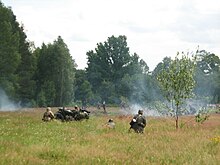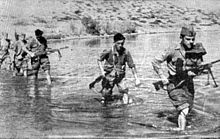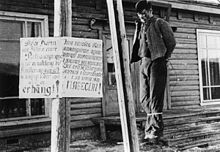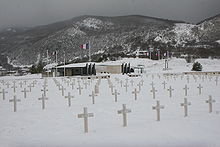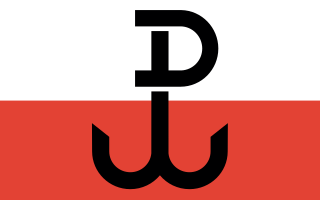
The Home Army was the dominant resistance movement in German-occupied Poland during World War II. The Home Army was formed in February 1942 from the earlier Związek Walki Zbrojnej established in the aftermath of the German and Soviet invasions in September 1939. Over the next two years, the Home Army absorbed most of the other Polish partisans and underground forces. Its allegiance was to the Polish government-in-exile in London, and it constituted the armed wing of what came to be known as the Polish Underground State. Estimates of the Home Army's 1944 strength range between 200,000 and 600,000. The latter number made the Home Army not only Poland's largest underground resistance movement but, along with Soviet and Yugoslav partisans, one of Europe's largest World War II underground movements.

Bronislav Vladislavovich Kaminski was a Polish-Russian Nazi collaborator and the commander of the Kaminski Brigade, an anti-partisan and rear-security formation made up of people from the so-called Lokot Autonomy territory in the Nazi Germany occupied areas of the Soviet Union, which was later incorporated into the Waffen-SS as the SS Sturmbrigade RONA. Older publications mistakenly give his first name as Mieczyslaw. Under Kaminski's command, the unit committed numerous war crimes and atrocities in the German-occupied Soviet Union and Poland.
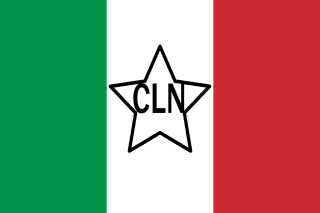
The Italian resistance movement is an umbrella term for the Italian resistance groups who fought the occupying forces of Nazi Germany and the fascist collaborationists of the Italian Social Republic during the Second World War in Italy from 1943 to 1945. As a diverse anti-fascist movement and organisation, the Resistenza opposed Nazi Germany, as well as Nazi Germany's Italian puppet state regime, the Italian Social Republic, which the Germans created following the Nazi German invasion and military occupation of Italy by the Wehrmacht and the Waffen-SS from 8 September 1943 until 25 April 1945.
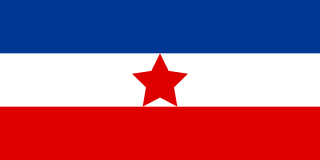
The Yugoslav Partisans, or the National Liberation Army, officially the National Liberation Army and Partisan Detachments of Yugoslavia, was the communist-led anti-fascist resistance to the Axis powers in occupied Yugoslavia during World War II. Led by Josip Broz Tito, the Partisans are considered to be Europe's most effective anti-Axis resistance movement during World War II.
Soviet partisans were members of resistance movements that fought a guerrilla war against Axis forces during World War II in the Soviet Union, the previously Soviet-occupied territories of interwar Poland in 1941–45 and eastern Finland. The activity emerged after Nazi Germany's Operation Barbarossa was launched from mid-1941 on. It was coordinated and controlled by the Soviet government and modeled on that of the Red Army.
During World War II, resistance movement occurred in German-occupied Europe by a variety of means, ranging from non-cooperation to propaganda, hiding crashed pilots and even to outright warfare and the recapturing of towns. In many countries, resistance movements were sometimes also referred to as The Underground. The resistance movements in World War II can be broken down into two primary politically polarized camps: the internationalist and usually Communist Party-led anti-fascist resistance that existed in nearly every country in the world; and the various nationalist groups in German- or Soviet-occupied countries, such as the Republic of Poland, that opposed both Nazi Germany and the Communists.

A partisan is a member of an irregular military force formed to oppose control of an area by a foreign power or by an army of occupation by some kind of insurgent activity.
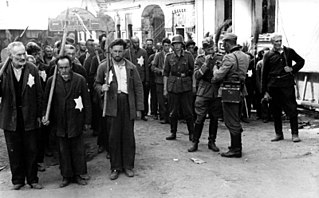
The German invasion of the Soviet Union started on 22 June 1941 and led to a German military occupation of Byelorussia until it was fully liberated in August 1944 as a result of Operation Bagration. The western parts of Byelorussia became part of the Reichskommissariat Ostland in 1941, and in 1943, the German authorities allowed local collaborators to set up a regional government, the Belarusian Central Rada, that lasted until the Soviets reestablished control over the region. Altogether, more than 2 million people were killed in Belarus during the three years of Nazi occupation, almost a quarter of the region's population, including 500,000 to 550,000 Jews in the Holocaust in Belarus.

The Belarusian resistance during World War II opposed Nazi Germany from 1941 until 1944. Belarus was one of the Soviet republics occupied during Operation Barbarossa. The term Belarusian partisans may refer to Soviet-formed irregular military groups fighting Germany, but has also been used to refer to the disparate independent groups who also fought as guerrillas at the time, including Jewish groups, Polish groups, and nationalist Belarusian forces opposed to Germany.

Jewish resistance under Nazi rule took various forms of organized underground activities conducted against German occupation regimes in Europe by Jews during World War II. According to historian Yehuda Bauer, Jewish resistance was defined as actions that were taken against all laws and actions acted by Germans. The term is particularly connected with the Holocaust and includes a multitude of different social responses by those oppressed, as well as both passive and armed resistance conducted by Jews themselves.

In Poland, the resistance movement during World War II was led by the Home Army. The Polish resistance is notable among others for disrupting German supply lines to the Eastern Front, and providing intelligence reports to the British intelligence agencies. It was a part of the Polish Underground State.

Poland was invaded and annexed by Nazi Germany and the Soviet Union in the aftermath of the invasion of Poland in 1939. In the pre-war Polish territories annexed by the Soviets the first Soviet partisan groups were formed in 1941, soon after Operation Barbarossa, the German invasion of the Soviet Union. Those groups fought against the Germans, but conflicts with Polish partisans were also common.

During World War II, Lithuania was occupied by the Soviet Union (1940–1941), Nazi Germany (1941–1944), and the Soviet Union again in 1944. Resistance during this period took many forms. Significant parts of the resistance were formed by Polish and Soviet forces, some of which fought with Lithuanian collaborators. This article presents a summary of the organizations, persons and actions involved. Lithuania was de facto independent from June 24, 1941, until June 30, 1941, when Nazi Germany took full control of the area.

The governments of the German Empire and Nazi Germany ordered, organized, and condoned a substantial number of war crimes, first in the Herero and Namaqua genocide and then in the First and Second World Wars. The most notable of these is the Holocaust, in which millions of European Jewish, Polish, and Romani people were systematically abused, deported, and murdered. Millions of civilians and prisoners of war also died as a result of German abuses, mistreatment, and deliberate starvation policies in those two conflicts. Much of the evidence was deliberately destroyed by the perpetrators, such as in Sonderaktion 1005, in an attempt to conceal their crimes.

World War II in the Kingdom of Yugoslavia began on 6 April 1941, when the country was invaded and swiftly conquered by Axis forces and partitioned among Germany, Italy, Hungary, Bulgaria and their client regimes. Shortly after Germany attacked the USSR on 22 June 1941, the communist-led republican Yugoslav Partisans, on orders from Moscow, launched a guerrilla liberation war fighting against the Axis forces and their locally established puppet regimes, including the Axis-allied Independent State of Croatia (NDH) and the Government of National Salvation in the German-occupied territory of Serbia. This was dubbed the National Liberation War and Socialist Revolution in post-war Yugoslav communist historiography. Simultaneously, a multi-side civil war was waged between the Yugoslav communist Partisans, the Serbian royalist Chetniks, the Axis-allied Croatian Ustaše and Home Guard, Serbian Volunteer Corps and State Guard, Slovene Home Guard, as well as Nazi-allied Russian Protective Corps troops.
Belarusian resistance movement are the resistance movements on the territory of contemporary Belarus. Wars in the area - Great Northern War and the War of the Polish Succession - damaged its economy further. In addition, Russian armies raided the Polish–Lithuanian Commonwealth under the pretext of the returning of fugitive peasants. By mid-18th century their presence in the lands of modern Belarus became almost permanent.

The Zamość uprising comprised World War II partisan operations, 1942–1944, by the Polish resistance against Germany's Generalplan-Ost forced expulsion of Poles from the Zamość region (Zamojszczyzna) and the region's colonization by German settlers.

In German military history, Bandenbekämpfung, also referred to as Nazi security warfare during World War II, refers to the concept and military doctrine of countering resistance or insurrection in the rear area during wartime through extreme brutality. The doctrine provided a rationale for disregarding the established laws of war and for targeting of any number of groups, from armed guerrillas to the civilian population, as "bandits" or "members of gangs". As applied by the German Empire and later by Nazi Germany, it became instrumental in the mass crimes against humanity committed by the two regimes, including the Herero and Namaqua genocide and the Holocaust.

Railway sabotage was one of the main tactics used by the resistance to German occupation during World War II. Partisans and rail workers used sabotage to harass and confuse the invaders, misdirect, destroy, and lose their troops and supplies, and to damage railroad infrastructure, denying the occupiers its use.
